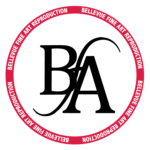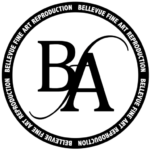FREQUENTLY ASKED QUESTIONS
Art Scanning Questions
Q. How does your scan pricing work?
Q. How is my artwork scanned? What equipment do you use?
Q. What do I get with my scan?
Q. At what resolution do you scan artwork?
Q. If you scan my original, can you print it at a different size?
Q. What is your turnaround time? How long does it take?
Q. What makes your scans different from other scans, or a photo?
Q. Are there paint/paintings that don’t reproduce well?
Q. Can you scan iridescent colors?
Q. Do you offer any kind of warranty?
Q. How long do you store my files?
Q. What about copyright considerations?
Q. At what depth do you scan artwork?
Q. In what color space do you save your art scans?
Q. In what file format do you save your art scans?
How does your scan pricing work?
A single scan, covering an area of up to 36″x48″ is $90.00. We will put up to two images in a scan for $90.00. We charge a $15.00 separation fee for additional images, and we will put up to four images in a scan. This makes our fine art scans very cost effective.
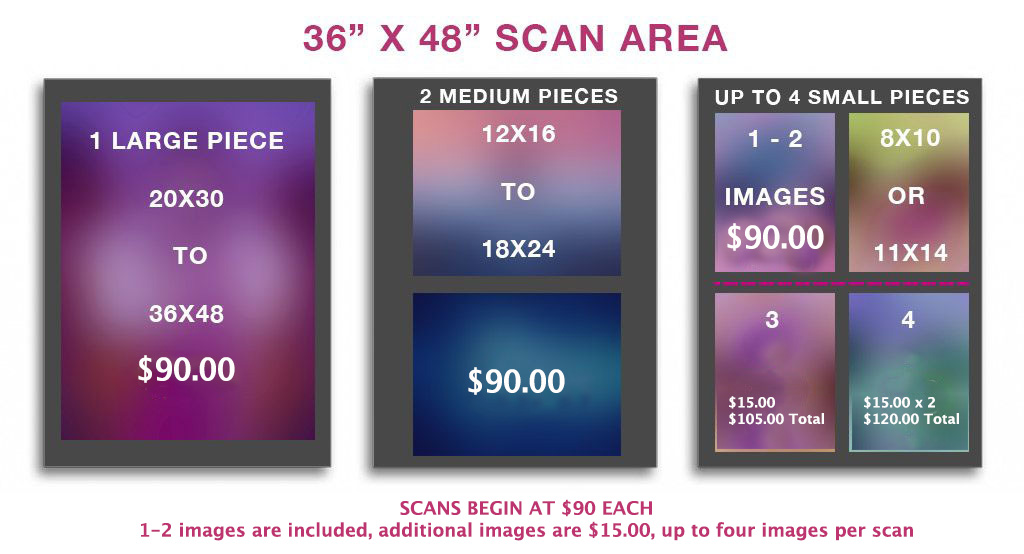
How is my artwork scanned? What equipment do you use?
We scan original artwork using our BetterLight 150MP large format scanning back camera and special lighting or a Fuji GFX100 105MP medium format camera and special lighting, depending on the project. We have invested many thousands of dollars in the best fine art digitizing equipment in order to ensure that your artwork is captured perfectly. Our main scanner covers an area of about 36″x48″ at 300 PPI, but we can scan at higher resolution for special needs. Below is a video explaining our large format scanning process.
Are you thinking, “where can I find fine art scanning near me?” Well if you’re in the Northwest, then we are the place to go for fine art scanning! But we also receive artwork from around the country, so regardless of where you live, we can offer you our fine art scanning services.
Whatever the scan job, we have the equipment and expertise to handle it. From large format scanning, to the scanning and digitization of smaller works, and any art medium you can think of, we can handle the work. We also get scanning requests for everything from books to collage albums, journals, architectural drawings, blueprints, stamp collections and more. You name it, and we’ve scanned it.
With very small detailed drawings and artifacts, we use macro lenses and a 105MP medium format camera to capture the image at super high resolution. Extra charges may be associated with special art scanning that requires custom setup. Please ask us for a scanning quote if you have any questions.
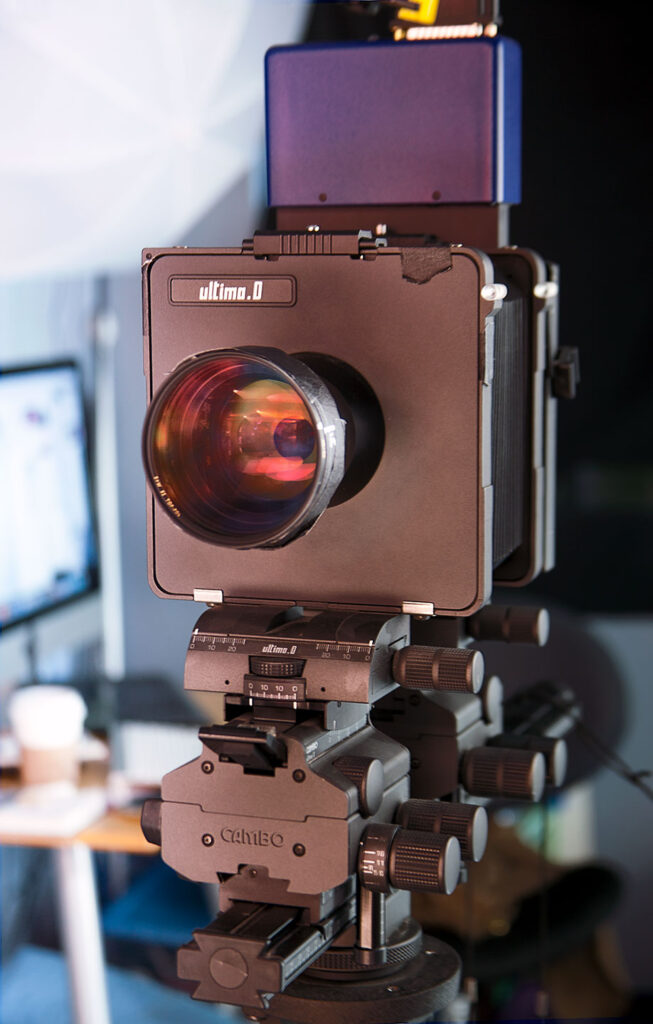
What do I get with my scan?
Each Scan comes with the full resolution .Tiff file of your piece (generally 300ppi – 330ppi at original size), and a pre-formatted reduced size .jpg, ideal for email, web pages, or social media. You will receive a small physical proof on our proofing paper so you can see how the color will print.
As part of the scanning service, we will always provide your files to you via dropbox. Simply download the files onto your computer at home!
For slide scans we offer the files in DNG and JPG format, depending on your needs.
For book scanning, artist journals, artist sketchbooks and some other document collections, we provide the files in PDF format. We may also provide the individual raw files in TIF or JPG format as well.
At what resolution do you scan artwork?
We scan images @ 300 ppi (pixels per inch) or higher, at the size of the image. If you want to know how many pixels that will be, multiply the number of inches by 300 on both sides (H x 300 * W x 300) of your artwork or image. However, because our scanner scans each color channel separately, it creates a higher quality pixel than a standard flatbed scanner. What all this means is that our 300 ppi scan produces a clear, high quality file of your work that will easily allow you to print twice as large as your original. Some flatbed scanners may claim higher ppi but the images they produce may still be lower quality and often do not print as crisply at enlarged sizes.
Oversized images (larger than 36×48) may be scanned at less than 300 ppi, or they may be scanned in sections and stitched together to produce full size 300 PPI images that can be used for fine art printing at the original size or larger.
Our art scans have been used for billboards, wall murals, huge outdoor banners and more.
If you scan my original, can you print it at a different size?
Yes. Once we have scanned your artwork, it can be printed in various sizes. In general we discourage people from enlarging their artwork too much. Even if the resolution is great, it becomes like looking at a painting through a magnifying glass. You start to see all the little imperfections, dog hairs, close-up brush strokes etc. But it’s very easy to take a scan and make various smaller sizes. This is very helpful for selling artwork, as many times buyers won’t have room for a large painting in their house or apartment.
The exception to this is when people are reproducing banners, billboards and signage that will be enlarged, in which case the image is generally viewed from far away and doesn’t need the same fidelity as an art print. We have done scans that were used for billboards, and the sides of buildings.
Here’s a video of Tenhun using our scans for a huge mural that went on the side of a building.
The only thing to keep in mind is aspect ratios! This cannot be emphasized enough. When making various smaller sizes of an image, it needs to be reduced proportionally. For example, you cannot take a 24″ x 36″ painting, and make an 8″x10″, unless you crop off two inches. From a 24″ x 36″ painting, you can make an 8″x12″, as both have a 2:3 ratio. An 8″x10″ has a 4:5 ratio.
If you don’t understand this (which is understandable for those of us who don’t like doing math), we have a very handy Aspect Ratio Calculator on our website. You can use it to calculate the different sizes at which your image will print. All you need to know is the original size in pixels, cm, or inches, or feet. Then you put in either the length or width of the new size you want and it will calculate the other dimension. Give it a try.
What is your turnaround time? How long does it take?
Normally our turnaround time for art scans is 2-3 business days depending on our queue at the time. We guarantee a 5 working day turnaround time. Since we encourage most clients to look at proofs before printing new scans, you should plan for two turn-around periods for a Scan + Print order (3-5 days for the scans, and another 3-5 days for the prints). Note that we ask for 5 working days for a scan, and if you must have it before then, we charge a rush fee, which we will talk about next.
Do you take rush orders?
We charge $$$ for rush orders if our scanning queue allows for a rush job. We’ll only commit to a rush order if we know we can meet your deadline. For large orders of multiple scans, there may be additional rush charges. If you are a first time client, we may not be comfortable doing a rush order. The Fine Art Printing and Scanning process can have a learning curve, and if we have never worked with you before, starting with a last-minute rush order may do both parties a disservice. We rarely offer “Scan while you wait services” and if we do, we charge $125 per hour with a two hour minimum. Our art scanning process is a very hands on service, and require a trained professional to closely match the colors of the original piece to the digital file.
However, there is a caveat to Rush jobs. Remember the saying, “You can have it right, or you can have it now, but you can’t have it right, now“? All of the work we do requires attention to detail, and the more we try to rush the process, the more likely it is that something will go wrong.
If you are up against a deadline and you are ordering prints or scans at the last minute and find a problem, such as an error that we didn’t notice, then we may or may not be able to fix any issues in time for your deadline. We make our very best effort to help you because we like and respect our clients, yet we need to ask for your understanding and cooperation when it comes to “emergency printing and scanning”. We’re not Kinkos, and we’re not the fire department, but we will do our best with the resources we have.
What makes your scans different from other scans, or a photo?
Our system is set up specifically for documenting artwork. Other scanners (flatbed scanners and drum-scanners) are setup to best capture documents, or transparent slides, etc, but this often means that they cannot do justice to your original artworks. You will find that the color is off in many cases, and that the levels and contrast will not match your original very well. Since our system is designed with original art in mind, the scans are much more accurate to the original in most cases. Even the best digital cameras create very small files compared to a scanner. While you can sometimes take photos yourself that look close to the original piece, the resolution is often still too small to make high quality prints from (even the best professional DSLRs often don’t print larger than 20×30)
Our lighting setup is designed with cross-polarization (UV filters on the lens and the lights), which reduces the glare on shiny paintings. Most oil paintings will show very little spectral highlights in the scan, and if any do occur we will do our best to remove them. Fully varnished or resin-coated pieces are most at risk for this, but we can still scan them in many cases (unless they are very large). Watercolors turn out beautifully on our scanner because it does not capture the texture of the paper, so when you reprint your watercolor on a watercolor paper it will be as close to the original as possible.
Here is a comparison of a piece that was photographed professionally with a high-end DSLR (Canon 5d mark iii), and then scanned with our Betterlight Scanner.
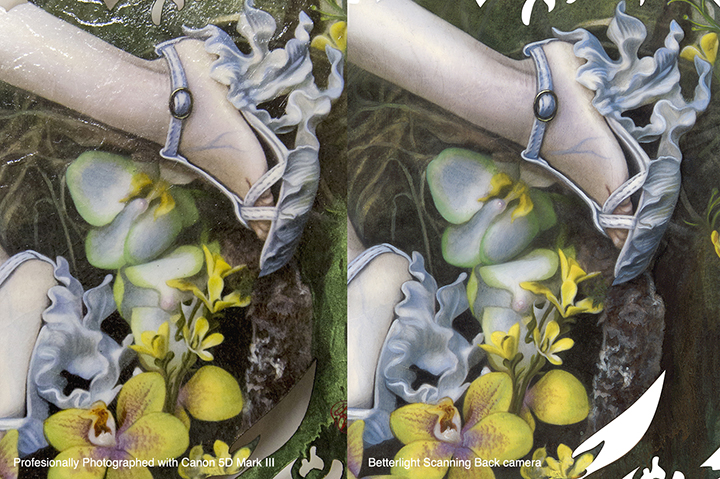
As you can see, the photo-version has a lot of specular highlighting and glare, while the scan is pristine and only showcases the colors of the piece. The levels of the photo also do not match the original (they are much too strong so the image loses detail), while the scan is very close to the original. The photo has some distortion from the lens, while the scan does not have lens distortion. The photo has a filesize of approximately 16MB while the scan has a file size of approximately 125MB (for a 16×20 piece). The photo does show off the metallic pigment more (towards the bottom right) but at the expense of color/resolution/specular highlighting, etc. While many of these differences are very noticable on-screen, it really becomes a huge issue when its time to make prints. A digital file that has to be up-rezzed or has color and glare issues will not print well.
Here is a more common example of a photographed work compared with one of our Betterlight Scans. The original piece is a very small and extremely detailed colored pencil drawing. Its easy to see that the regular photograph doesn’t pick up any of the detailed line-work, and the contrast is much too strong.
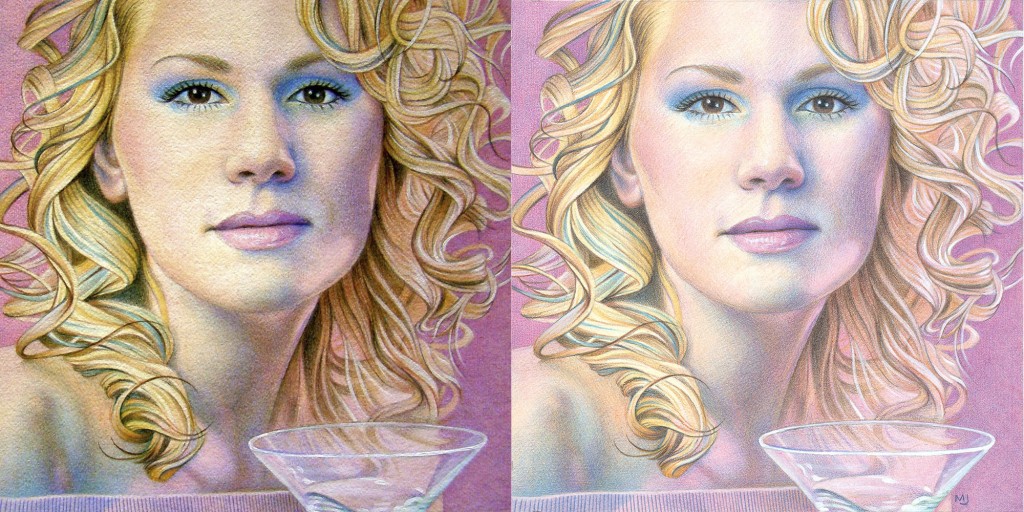
Comparison of the difference between the photo (left) and Betterlight scan (right) Artwork by Mary Jane Easley (www.easleystreetstudios.com)
Are there paint/paintings that don't reproduce well?
While our scanner is the best-available technology for documenting artwork with a high-degree of color accuracy. Certain pigments and paint effects are outside of the scope of this process. Metallic paints and metal leafing are problematic and often can’t be captured, as they represent the reflective properties of a metallic element, as opposed to a color range. We have a few special techniques that can produce a better result with certain pieces, but this is on a case by case basis. Here is a video showing how we scan and edit gold, silver and iridescent colors.
Below are some examples of artwork which included gold and metallics, as captured by our scanner. Often, the pieces that turn out the best have isolated areas of gold or silver, rather than metallic pigments mixed into the rest of the image or very fine metallic line-work or details.
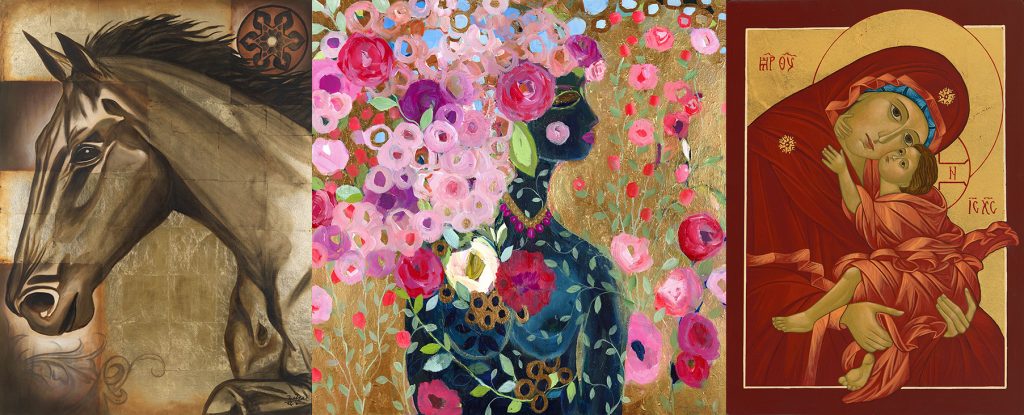
Do you scan iridescent colors?
No. This should be explained in the previous question, but we’re getting this question a lot due to increased availability of iridescent paints, especially acrylics.
First, it’s important to understand what iridescent is; it is an optical phenomenon characterized as “the property of surfaces in which hue changes according to the angle from which the surface is viewed.”
Iridescence is caused by multiple reflections from multi-layered, semi-transparent surfaces in which phase shift and interference of the reflections modulates the incident light by amplifying or attenuating some frequencies more than others. 1
From a physics standpoint this is rather uncommon behavior, and in man-made objects this is usually only found in paints that are specifically designed for this effect. Therefore, iridescent behavior is the behavior of a special property not found in regular pigment or dye based inks. Also, because the apparent image changes with the angle of observation, iridescence is not fully reproduced by conventional photography.
If we do reproduction work and your image includes iridescent paint, then you will get whatever color the camera sees when the work is perfectly perpendicular to the artwork. We have real samples in the studio of paint chips and paint samples that we’ve scanned and printed that show exactly what an artist can expect with certain types of paint.
Do you offer any kind of warranty?
Yes. First we guarantee you will be satisfied with the quality of the scan, or we will remake it or refund your money in full. We believe in the quality of our work and stand behind it 100%. If for any reason you are not satisfied we will either refund your money or make it right (within 30 days from when you receive the order). Please check over your scans and prints carefully when you receive them, so we can help you as soon as possible if there is a problem. Note that if we feel we have come as close to the original as we reasonably can, we may offer a refund or charge for additional editing. We do not promise to offer a perfect match in every sense. Some things shift color more than others, and color accuracy is subjective. There is a limit to what we can and will do for a $85 scan.
Warranty of color: We do our best to match your original colors, and ask you to check the color proofs when you pickup your original artwork and proofs. However, this does not always mean absolute perfection, as stated above, especially with color, which is subjective. If a client asks us for new proofs, and we have to run multiple proofs until you are absolutely satisfied, we charge an extra proofing fee. In some cases a client wants us to produce multiple proofs for a complete museum match, and asks for very subtle color changes after we have completed the job, and we do charge extra for that., and sometimes we will tell a client that we can’t reasonably come closer at any price.
How long do you store my files?
We promise to keep your files for up to 2 years if there is no printing activity. This is our liability disclaimer (although we make no claim for liability for loss of your files if you lose your copy).
Although we only guarantee to keep your files for two years, we have over 15 years of files as of 2023, and have never discarded or lost any of our art scans. We have off-site backups as well, so chances are pretty good that your art files are safe with us no matter how long it’s been.
Clients are advised to keep a copy of their files and treat them as you would other valuable electronic documents, photos or heirlooms. We charge $20 to provide past scans if you lost them, and they are provided via dropbox.
What about copyright considerations?
We keep images from your art scans strictly confidential. Bellevue Fine Art Reproduction does not allow any artwork or images to be printed without the artist or copyright holder’s authorization. Artists maintain complete copyright over their own files and images! We make no copyright claims to an artist images and we provide artists their own copy of the high resolution images. We keep your files as a convenience and service.
We’re often asked if we require artists to sign a form stating that the work is theirs. In general the answer is no. We generally don’t check, and we can’t really be the copyright police. However, if it’s quite obvious that you don’t have rights to the artwork or image, then we can’t reproduce it and may ask for something in writing.
We do have some copyright release forms for various reasons, and if we’re not sure then we’ll ask you to sign a liability release form, and you’re on your way.
The exception to this is art collectors who have rare pieces in their collections and want to have a digital backup and a copy for various reasons. In some cases collectors need high quality art scans to show in catalogs on the Internet, or for portfolios, which may fall under fair use.
In some cases older art work is no longer copyright protected, and the owner is free to do what they want with the artwrok. Collectors also want high quality art scans of valuable artwork for archival and insurance purposes, which is a legitimate use.
At what bit depth do you scan artwork?
Bit Depth: Our professional scans are supplied at 8 bits per RGB color channel. We edit the files and color proof at 16bit, then change the file to 8bit when we’re finished, except in special cases. In most cases 16bit files become huge and difficult to manage, and in most cases there is no advantage to having your artwork scans at 16bit. Only in cases where there are large soft gradients, such as a subtle blue sky, is it necessary to keep your artwork or photography at 16bits.
Flatbed scanners operate a little differently, and they call their files 48bit and 24bit (16bits per color channel or 8bits per color channel, across the RGB color channels). A 48bit image does not have a greater dynamic range (maximum shadow to maximum highlight range) than 24bit but more tonal ‘steps’ within this range.
In what color space do you save your art scans?
Colour Space: Our professional art scans are output with ‘Adobe RGB 1998’ colour space. This large colour space is used for professional photographic and fine art Giclee printing. Adobe RGB files can be converted DOWN to the smaller sRGB colour space but if you convert sRGB files UP to Adobe RGB you will still have a file with missing colours! None-the-less we recommmend leaving your fine art scans in the Adobe RGB 1998 color space. We also advise against using Pro Photo, as it describes colors that cannot be viewed or printed.
Here’s a video to help understand ICC color spaces.
In what file format do you save your art scans?
File Formats: For professional art scans we supply uncompressed single or multi layer TIF files in Windows format as Macintosh computers will also open these. We can also supply as PSD (PhotoShop) files and other formats but you should be aware that some compression is inherant. We supply our art scans in TIF format because they can handle layers, and TIF files are industry standard and program neutral, and can be opened by any graphic editing or photo editing software, so that artists aren’t locked into Adobe Photoshop.
We also supply lower resolution jpg files with every art scan so that artists have jpg files that are ready to use on websites and share in social media, such as artist’s facebook pages, Instagram, Pinterest, WordPress blogs etc.
I'm having trouble downloading TIF files from Dropbox...
After your scans are finished, and we send you the dropbox link, that link will open a webpage to dropbox. In the upper right hand corner there is a button to download your files. Using this method will download all of your scan files, both TIF and JPG, as a zip file.
Note that dropbox may display thumbnails for some or all of the web jpgs (the preview jpg files meant for web and social media), but it cannot display thumbnail images for the tif files because they are too large. This is normal and it’s not a problem.
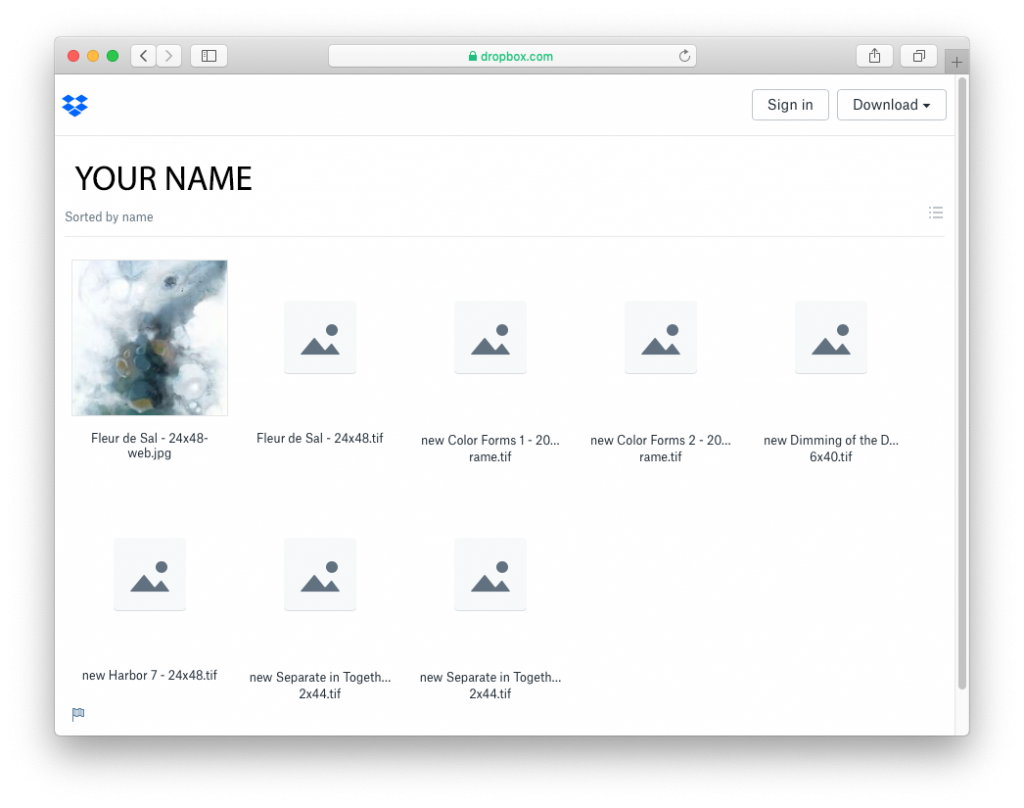
If you want to download a single file, or if you want to download your files one at a time, you may encounter an error when clicking on TIF files that says dropbox had an error. The error is that although dropbox recognizes the TIF files as image files and wants to display them, it cannot because the files are too large. Simply ignore the error and click on the download button as shown here:
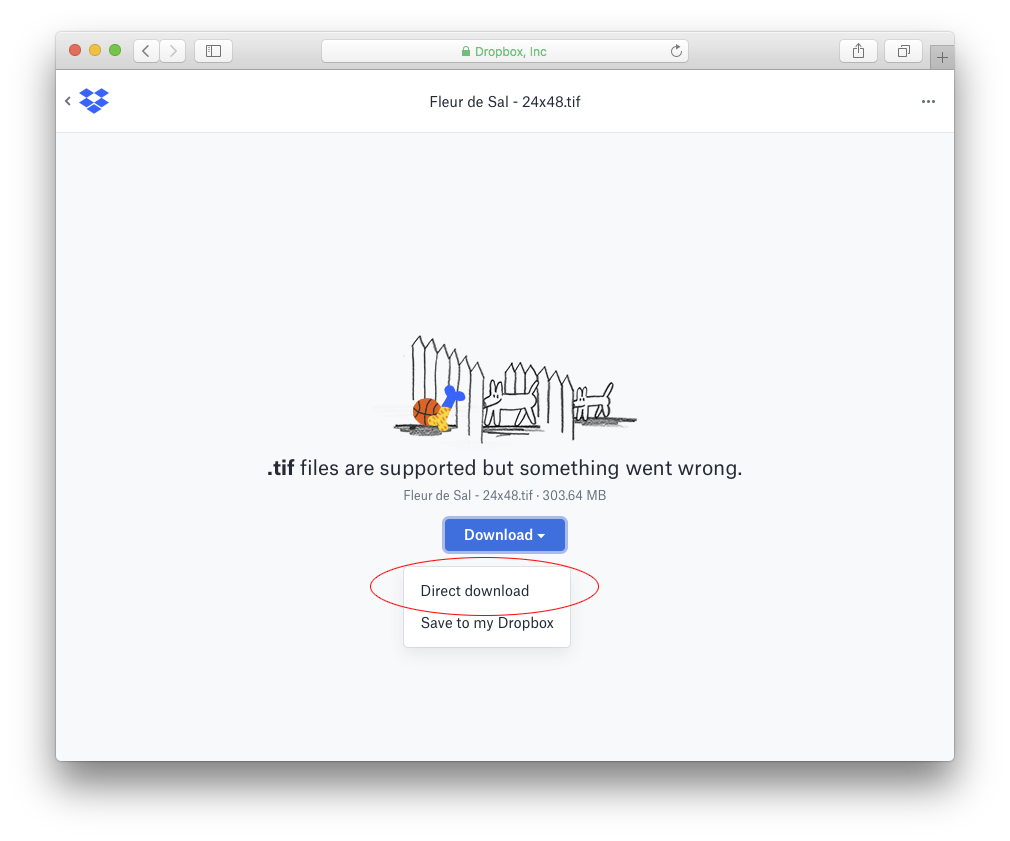
Select “direct download” to download the file to your computer.
Rest assured there is nothing wrong with your file. Simply download the file and then open it on your computer using Photoshop or a similar photo editing software. Note that if you use the built in image previewer that comes with both MAC and Windows, the file may take time to open depending on the speed and power of your computer. Some of our files exceed a gigabyte depending on image size.
If I'm mailing in originals to scan, what should I do?
If you are mailing in original artwork for scanning, or having a friend drop-off work for you, please complete our Artwork Dropoff Form so we have all the important information about your originals. Also be sure to include all of your contact information with the artwork, so we know who the art belongs to. We will contact you once we have received the work to let you know it is safe!
If you are wondering how to safely ship your artwork, check our our Shipping page.
